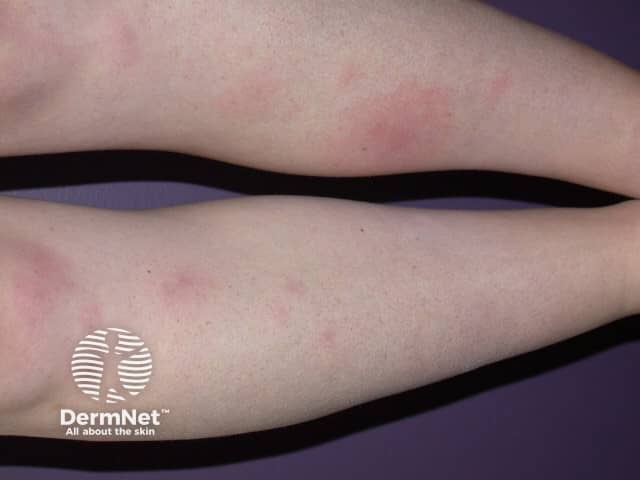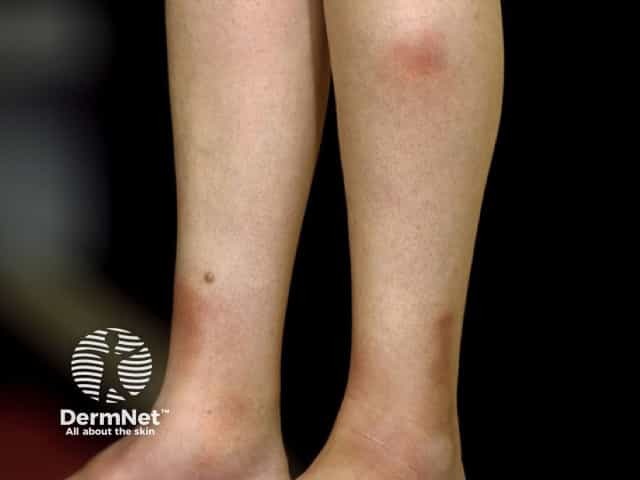Main menu
Common skin conditions

NEWS
Join DermNet PRO
Read more
Quick links
Löfgren syndrome — extra information
Löfgren syndrome
Author: Dr Antonia Birry, Dermatology Registrar, Middlemore Hospital, Auckland, New Zealand; Chief Editor: Dr Amanda Oakley, Dermatologist, Hamilton, New Zealand, October 2015.
Introduction
Demographics
Causes
Clinical features
Diagnosis
Treatment
Outlook
What is Löfgren syndrome?
Löfgren syndrome is an acute form of sarcoidosis. Sarcoidosis is a multisystem disorder characterised histologically by granulomas (a specific type of inflammation).
Löfgren syndrome presents with a combination of symptoms and findings:
- Erythema nodosum
- Bilateral hilar lymphadenopathy (enlarged lymph nodes in the centre of the chest)
- Bilateral ankle arthritis or painful ankles
- Fever and malaise
The syndrome is named after Swedish researcher, Sven Löfgren (1910-1978), who described the symptoms in a series of 113 patients (1953).
Who gets Löfgren syndrome?
Some populations are at greater risk of developing Löfgren syndrome for genetic and environmental reasons.
- There is a strong female predominance
- It affects young to middle age patients, with a mean age of onset of 35 years
- Löfgren syndrome is more common and more severe in Scandinavia and Ireland
- There is a strong association with HLA-DRB1 allele.
What causes Löfgren syndrome?
Despite intensive investigation, the cause of Löfgren syndrome and other forms of cutaneous sarcoidosis is unknown. Sarcoidosis is recognised as a cell-mediated immune response to an unknown antigen, in which activated macrophages and CD4 T-lymphocytes release cytokines that trigger formation of granulomas.
At least some cases of cutaneous sarcoidosis may be due to an unusual host reaction to one or more infective agents, such as Mycobacterium paratuberculosis, histoplasmosis and other fungi. Acute sarcoidosis is not infectious.
What are the clinical features of Löfgren syndrome?
Löfgren syndrome commonly presents during the spring months.
Erythema nodosum
- Erythema nodosum is predominantly noted among women.
- Tender nodules are most often located on the lower limbs but may occasionally also occur on forearms

Erythema nodosum

Erythema nodosum

Erythema nodosum
See more images of erythema nodosum
Ankle arthritis
- Bilateral ankle arthritis is more frequently seen in men.
- It results in pain and/or swelling
Systemic symptoms
- Fever and malaise
- Respiratory symptoms: mild shortness of breath and decreased exercise tolerance
- Acute uveitis or iridocyclitis (inflammation of the eye)
- Parotitis
How is the diagnosis of Löfgren syndrome made?
Patients with Löfgren syndrome may present to a dermatologist, respiratory physician, ophthalmologist, rheumatologist or general practitioner because of the variety of possible symptoms.
The diagnosis may be suspected due to typical clinical features. Although not always necessary for diagnosis, diagnosis of sarcoidosis is confirmed by finding non-caseating granulomas on biopsy of lymph nodes. Biopsy of erythema nodosum reveals septal panniculitis.
Chest X-ray reveals bilateral hilar lymphadenopathy ie enlarged lymph nodes in the centre of the chest.
Blood tests may find elevated levels of:
- C-reactive protein (CRP), calcium, angiotensin-converting enzyme (ACE), alkaline phosphatase, gamma globulin (polyclonal)
It is important to exclude tuberculosis. Tuberculin skin test and QuantiFERON® gold blood test are negative in sarcoidosis.
What is the treatment for Löfgren syndrome?
Most patients with Löfgren syndrome are treated with nonsteroidal anti-inflammatory drugs (NSAIDs), which reduce discomfort and inflammation of erythema nodosum and arthritis. Other drugs occasionally used for Löfgren syndrome include:
- Systemic steroids, eg oral prednisone, used for severe cases.
- Colchicine
Compression socks can reduce swelling and discomfort of erythema nodosum.
What is the outlook for Löfgren syndrome?
The prognosis of Löfgren syndrome is good, with complete resolution with or without treatment within 6 months to 2 years.
It is usual to repeat chest X-rays from time to time until the lymphadenopathy has fully resolved.
References
- Howard A. Non-infectious granulomas. In: Bolognia J. Textbook Dermatology. Vol.2.Mosby; 2008
- Gawkrodger DJ. Sarcoidosis. In: Burns T, Breathnach S, Cox N, Griffiths C, editors. Rooks Textbook of Dermatology. Vol. 3. Massachusetts: Blackwell Science Ltd; 2010. pp. 61.1–21.
- Chadwick P. Sarcoidosis In: Lebwohl M. Treatment of Skin disease, Fourth edition, Elsevier, 2008
- Petrilla J. Lofgren's syndrome: A clinical variant of sarcoidosis. Hospital physician 2002, pp 40–3
On DermNet
Other websites
